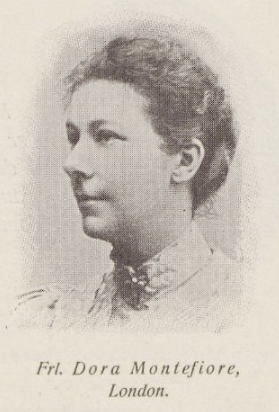Dora Montefiore facts for kids
Dorothy (Dora) Frances Montefiore (born Fuller; 20 December 1851 – 21 December 1933) was an important English-Australian activist. She fought for women's suffrage (the right for women to vote) and was a socialist, a poet, and wrote her own life story.
Contents
Dora's Early Life
Dora Montefiore was born Dorothy Frances Fuller in Kenley, Surrey, England. Her father, Francis Fuller, was involved in railway engineering and helped with the famous the Great Exhibition. Her mother, Mary Ann Fuller, came from a family that developed land. Dora was taught at home by tutors and also went to Mrs Creswell's school in Brighton.
In 1874, Dora traveled to Sydney, Australia, to help her brother's wife. She returned to England for a short time, then went back to Sydney. There, she married George Barrow Montefiore, who was a Jewish merchant. They had two children together.
A sad event changed Dora's life in 1889: her husband was lost at sea. After this, Dora found out she didn't automatically have the right to be the legal guardian of her own children. This unfair rule made her a strong supporter of women's rights. The very first meeting of the Womanhood Suffrage League of New South Wales was held at Dora Montefiore's home on March 29, 1891. In 1892, Dora left Australia. After living in Paris for several years, she settled in England.
Fighting for the Vote (Suffragette)
Dora Montefiore became a socialist, meaning she believed in a fairer society where everyone had equal rights. She strongly felt that women needed the right to vote. She saw this as a way to help all women, especially those who were not wealthy.
In 1898, Dora wrote a book of poems called Singings Through the Dark. She also stayed very active in the movement for women's voting rights. She was part of the leadership for the National Union of Women's Suffrage Societies, led by Millicent Fawcett. Later, she joined the Women's Social and Political Union (WSPU), which was started by Emmeline Pankhurst and Christabel Pankhurst.
In 1897, Dora suggested forming the Women's Tax Resistance League. This group believed that if women couldn't vote, they shouldn't have to pay taxes. In 1906, to protest the fact that women couldn't vote, Dora refused to pay her taxes. She stayed inside her home for six weeks, blocking the doors so tax collectors couldn't get in. Her house had a large sign that said: "Women should vote for the laws they obey and the taxes they pay." She explained that she was doing this to speak for all women who couldn't protest in the same way.
Later that year, Dora Montefiore and others were arrested for demanding votes for women at the House of Commons of the United Kingdom. Dora later wrote about her experience in Holloway Prison. She also joined several socialist groups, like the Women's Freedom League and the Communist Party of Great Britain. Dora was good at languages and was the first person to translate the writings of Maxim Gorky into English.
Dora was friends with other suffragettes like Adelaide Knight and Minnie Baldock. She spoke at Minnie Baldock's group meetings. Dora eventually left the WSPU and joined the Adult Suffrage Society in 1909. This group wanted all adults, both men and women over 21, to have the right to vote, not just women who owned property. Dora's socialist ideas were similar to those of Sylvia Pankhurst, and they stayed in touch.
Later Life and Travels
Dora Montefiore gave speeches in Holland and traveled around Europe and the United States. In 1910, she returned to Australia to visit her son, Gilbert. While in Australia, she helped edit a newspaper called International Socialist Review of Australasia. She also met the Premier of New South Wales, William Arthur Holman. In 1912, Dora went to South Africa and wrote about how capitalism affected people there.
In 1913, Dora was involved in a plan to help children in Dublin, Ireland. Strikes there had caused food shortages, and the plan was to bring the children to Britain so they wouldn't suffer. This plan caused some controversy, but the charges against those involved were later dropped.
During the First World War, Dora volunteered in France. She also joined the British Socialist Party and wrote articles for their newspaper, The Call. In 1920, she was chosen to be part of the first council of the Communist Party of Great Britain.
Sadly, Dora's son died in 1921 from an illness he got during his service in the war. The Australian government initially didn't want Dora to visit Australia because of her communist beliefs. However, Premier Holman spoke up for her, and she was allowed to visit after promising not to spread communist ideas. While there, she also connected with the Australian communist movement. In 1924, Dora represented the Communist Party of Australia in Moscow.
Dora Montefiore wrote her autobiography, or life story, in 1927. It was called From a Victorian to a Modern.
Dora Montefiore passed away at her home in Hastings, England, in 1933. She was cremated at Golders Green Crematorium.
Posthumous recognition
Dora Montefiore's name and picture are featured on the base of the statue of Millicent Fawcett in Parliament Square, London. This statue was revealed in 2018 and honors 58 women who supported women's right to vote.
See also
 In Spanish: Dora Montefiore para niños
In Spanish: Dora Montefiore para niños


